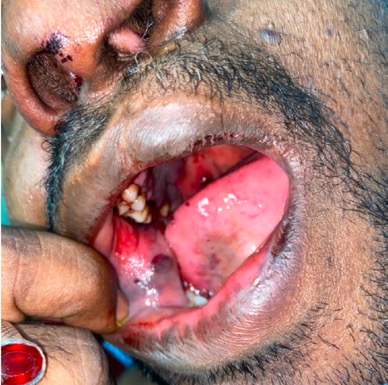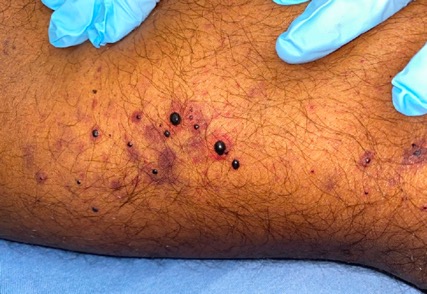Case Presentation: A 40 year old recently immigrated Indian male with medical history significant for two episodes of hemorrhagic dengue fever presented with a three day history of epistaxis, gingival bleeding, hematuria, hematochezia and a vesicular rash. On presentation, the physical exam was remarkable for a large mucosal hematoma, gingival bleeding, and diffuse hemorrhagic vesicular lesions on the trunk and bilateral thighs. Initial labs were significant for a platelet count 4000/mcL, hemoglobin 12.2 g/dL, total bilirubin 1.5 mg/dL, peripheral smear was without clumping or noted morphologic cell abnormalities. Infectious workup revealed a positive dengue antibody with negative antigen, consistent with a prior infection. HIV, Hepatitis C, CMV, and EBV antibodies were negative. Hematologic workup revealed normal ADAMTS13, negative platelet antibody screen, and no splenomegaly on ultrasound. Bone marrow biopsy was benign, noting increased megakaryocytes consistent with a reactive process. The patient was treated for suspected immune thrombocytopenic purpura (ITP) with two platelet transfusions and 40mg dexamethasone daily for four days. Due to a poor initial response to treatment, the patient was initiated on IVIG. Despite IVIG, the patient continued to have a poor clinical response. Helicobacter Pylori (H. Pylori) stool antigen testing was performed and was positive. Quadruple therapy was initiated and by the third day of treatment, the patient demonstrated a significant increase in platelets 103,000/mcL. The patient’s symptoms resolved and he was discharged home. Eltrombopag and prednisone were initiated on follow up with hematology.
Discussion: ITP is an acquired condition characterized by autoantibody destruction of platelets. While the association between H. Pylori infection and ITP is not completely understood, the most commonly cited theories suggest molecular mimicry occurs due to cross-reactivity between H. Pylori virulence factors and platelet surface antigens. In these cases, treatment of H. Pylori may lead to improved clinical response and increased platelet counts. Various studies have shown a greater improvement in clinical response in Eastern populations compared to Western populations after treatment for H. Pylori. It is postulated that this may be due to the increased prevalence in Eastern populations of more virulent H. Pylori strains containing the cytotoxin associated gene-A (CagA) virulence factor. CagA is extremely antigenic and anti-CagA antibodies show strong cross-reactivity to the GPIIb/IIIa platelets surface antigen. As such, in Eastern populations, treatment of H. Pylori has been linked to an increase in sustained platelet response to treatment. Our case further elucidates how the treatment of H. Pylori in secondary ITP may lead to a better treatment response and long term recovery of platelet count, especially in patients of Eastern descent.
Conclusions: Screening for H. Pylori should be performed in all cases of ITP.


